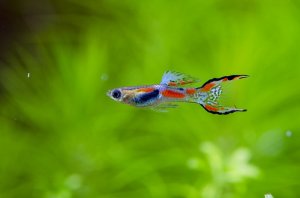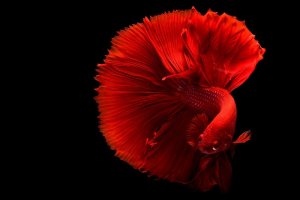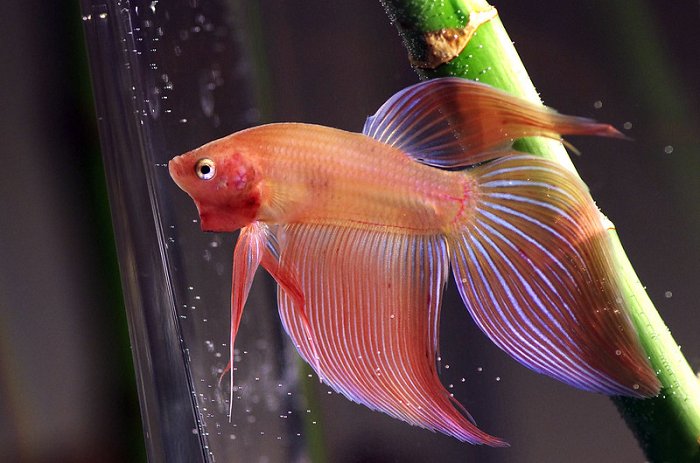
Owning a Betta Fish, pink or any other color, is a truly rewarding endeavor. These colorful fish are some of the most enigmatic and interactive of all aquarium species. What makes them so special? The Pink Betta Fish and all other Betta varieties show sexual dimorphism, meaning the male and female look different and even have different behavior.
Apart from this, keeping a Betta means a huge range of varieties to choose from, and every day with your pet will bring something new. Read on for a guide to basic care, feeding, tank setup, and even how to breed this magnificent Betta variety.
Breed Overview
| Origin | Rice paddies of Vietnam, Thailand, Laos, and Cambodia |
| Lifespan | 2-5 years |
| Size | Up to 3” or 7cm |
| Colour | Pink, bicolor |
| Food | Carnivorous |
| Tank Size | Minimum 20 gallons/76 liters |
| Temperament | Curious, lively |
| Water Type | Freshwater |
| Water Temperature | 74-82F/23-28C |
| Water pH | Neutral |
| Difficulty Level | Intermediate |
Tank Setup And Maintenance
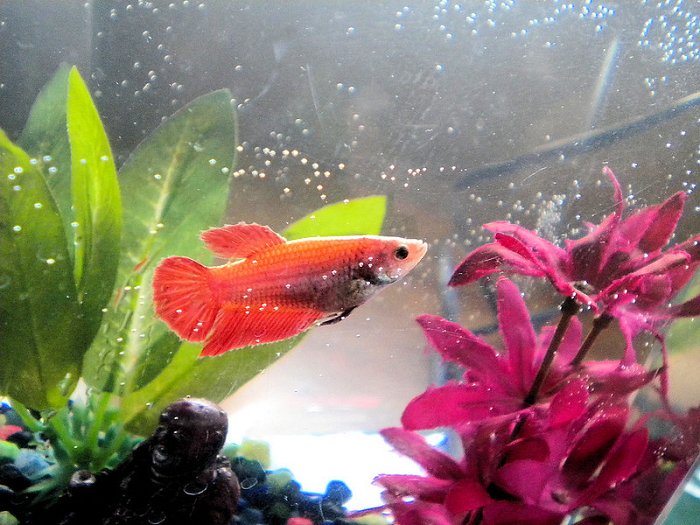
The modern Betta Fish has actually been selected through its history of usage in fights to be more aggressive than wild Betta Fish. As a result, you cannot keep more than one male Betta Fish in a tank, regardless of the color.
1. Basic Parameters
The best conditions for any betta Fish mimic those found in the rice paddies where their wild ancestors lived. These roughly correspond to the metrics below:
| Water Hardness | 3-4 dGh |
| Filtration | Flow rate 4x tank size, sponge filter ideal |
| Substrate | Gravel or sand |
| Tank Maintenance | Change 30% of the water per week and wash the sponge filter in water from the tank once every three months |
2. Planting And Tankmates
A Betta should ideally live in a well-planted tank with plenty of hiding places. Driftwood, stones, and caves are always popular with these intelligent and explorative fish. Luckily, as these fish are carnivores, they don’t uproot plants but prefer them to hide in. Good species that also come from Southeast Asia include Java fern and Java moss.
Male Betta Fish are best kept separate from other Bettas, although females can be kept in a sorority tank. However, ideal tankmates are small schooling fish like teras or harlequin rasboras, and bottom-dwellers like kuhli loaches. A good rule of thumb is that any fish with showy fins can become a target for your Betta’s aggression, whereas dull-colored fish with small tails tend to be safe.
Choosing Your Pink Betta Fish:
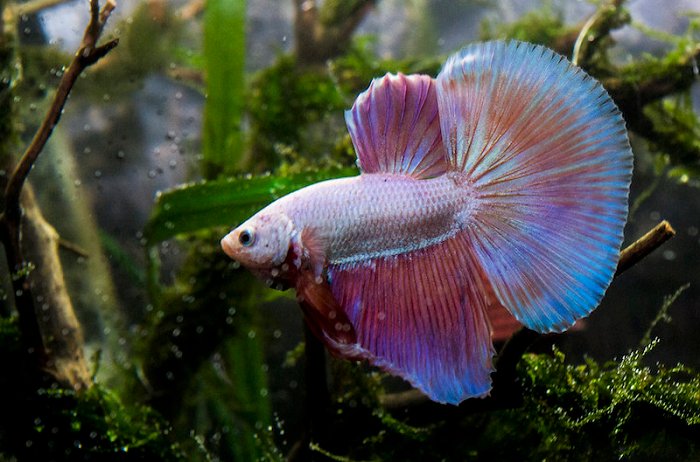
You may think you would be lucky even to find any variety of pink Betta Fish. However, did you know that they actually come in many variations? From coloration, exact hue, to tail type, despite the rarity of these fish, you will be able to find the one that is perfect for you.
1. Pink Orchid Betta Fish
The Pink Orchid Betta Fish is one particular variety that never fails to impress. What makes this fish stand out and gives it its distinctive name is the pattern of rings of different shades of pink on it’s tail, where pale pink sits next to white and a darker shade of magenta.
If you are certain you have found a true Pink Orchid Betta, this can be a great opportunity to set up a community tank with tankmates of another species. This is because the Pink Orchid Betta has actually been bred so that it is smaller and less aggressive than other sorts of Betta Fish.
2. Betta Fish Pink Female vs Pink Male
So, you might have your heart set on a Pink Betta Fish. But do you want a female or a male? If you prefer community tanks, then a female can be an underrated option. But for the iconic male, tankmates must be of a different species. Either way, the male and female of the Pink Betta Fish are similar to other Bettas. However, due to the reduced aggression of the Pink Orchid Betta Fish, it can be a good sorority option.
3. Betta Fish Tail Types
Pink Betta Fish come in all the different tail varieties of any other Betta Fish color. These include crowntail, plakat, halfmoon, and veilteil. However, due to the comparative rarity of the Pink Betta Fish, it may be harder to find your desired tail type than if you were after a red or blue Betta.
4. Pink Betta Fish Price
More common colors of Betta Fish tend to start at around USD. However, for the Pink Betta Fish, expect to pay up to 20 or 30 USD for this rare variety! Likewise, whilst you can find more common Betta Fish in pet shops, you may have to consult a specialist breeder for a Pink Betta Fish.
Feeding
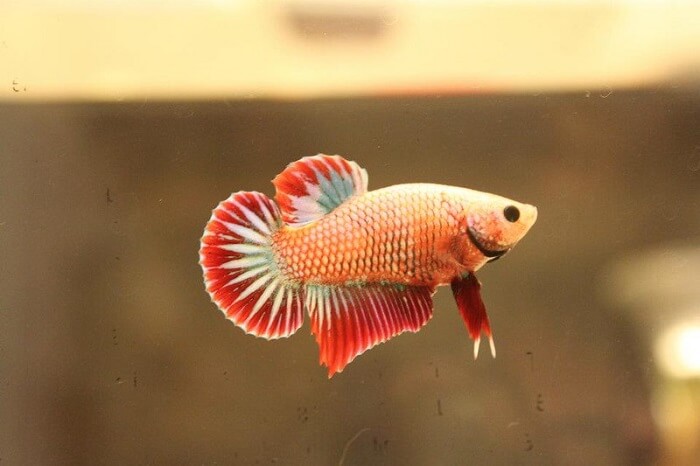
Betta fish are obligate carnivores, meaning they can only eat protein. They mostly enjoy small aquatic invertebrates, such as daphnia, tubifex worms, and brine shrimp, although the basis of their diet should be specialist Betta pellets with protein 2-3 times per week.
Only ever feed what your fish can eat within 5 minutes and clean up all uneaten food!
-
Color-Enhancing Foods For Pink Betta Fish
If you have a rare Pink Betta Fish, it’s likely you want to know how to preserve it’s beautiful color. Luckily, you can do this with diet. One of the best color-enhancing foods is salmon. As the Betta only has a small mouth, you can chop it up into tiny pieces and feed it in moderation, such as once or twice a week.
Behavior And Temperament
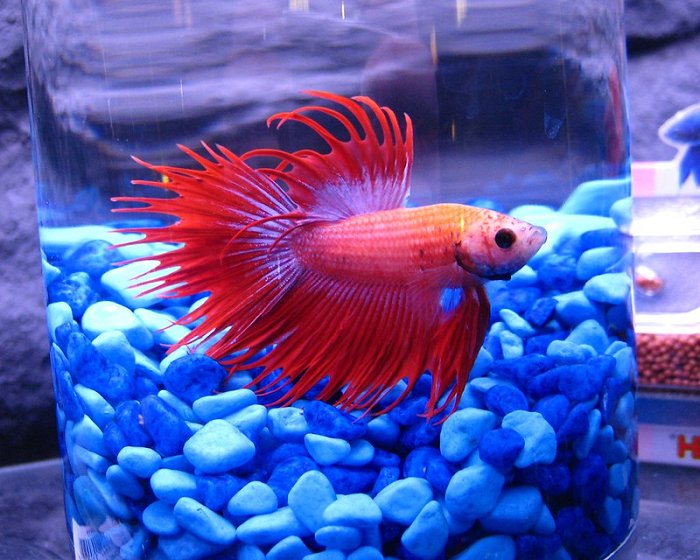
Betta Fish are normally active and inquisitive. Although their long tails prevent them from swimming very fast, they nevertheless are playful and intelligent. Sometimes you may see them resting near the bottom or top of the tank, which tends to be when they are asleep.
However, if they continue to show lethargy beyond this, and you are persistently wondering why your Betta Fish is not moving, changes to their normal active behavior can be a sign of disease.
Why Is My Betta Attacking My Other Fish?
If a Betta Fish, male or female, is attacking tankmates of any species, it is generally because they see them as a threat. This can happen to tankmates with flashy fins. Alternatively, poor water conditions and overcrowding can cause competition between fish. If the problem persists after a water change, it may be time to invest in a larger tank.
Author’s Note: In a sorority’ tank, one thing that raises the risk of aggression is owning two fish of the same or a similar color. This is why you will generally only see sorority tanks with fish of a rainbow of different colors. Female Betta Fish generally perceive females of the same color as a threat. Therefore, it is best to keep only one female pink Betta Fish in a sorority tank.
Pests And Diseases
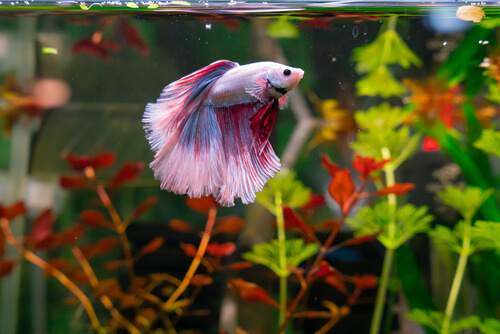
Like any ornamental fish, Pink Betta Fish can be prone to pests and diseases. These can range from fungal infections to bacterial infections like fin rot.
1. Fin Rot
Fin rot is an unpleasant bacterial infection that causes ragged, sore edges on the fins of your fish. Betta fish can be prone to it in dirty water. Fin rot can be treated by isolating the fish in a separate tank (if your fish has tankmates) and using over-the-counter antibacterial medication.
2. Velvet Disease
Unlike fin rot, velvet disease is caused by a protozoan parasite as opposed to bacteria. However, it is just as important to spot it quickly. You may not immediately notice something abnormal as this disease looks like metallic gold dust on your fish’s scales, giving it it’s other name ‘gold dust disease’ or ‘coral disease’. However, this is not a normal pattern of coloration for pink Betta Fish.
Like fin rot, it can be treated with over-the-counter medication.
Why Is My Pink Betta Fish Turning White?
There are many reasons why a Betta Fish can change color, ranging from old age to disease. However, a color change to white is generally due to poor water conditions and stress. These circumstances generally mean your fish does not have the energy to maintain its color.
Sometimes, poor lighting can also be a reason that your fish loses color. Lighting that is either too bright or too dim can cause a color change, so it’s best to use lighting that mimics the quality of natural light. This is generally plain muted white which mimics the light of a cloudy day and can be achieved with an LED light.
Do Betta Fish Change Color With Age?
The color of any Betta Fish is determined by multiple kinds of specialist pigment-producing cells, varying from melanophores to iridophores and xanthophores. As your fish gets older, its metabolism slows, meaning that it has less energy overall to maintain bodily functions.
Author’s Note: As color is not something that is necessary for the fish’s survival, if your fish doesn’t have the energy to maintain it, it may be one of the first things to go. Other signs your fish is growing old are that it is resting more, as well as eating less, as it simply needs less food.
Breeding
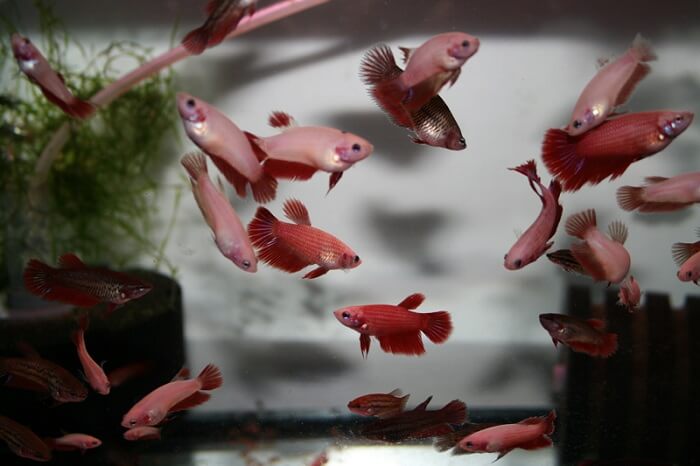
Although Betta Fish of any variety look delicate and exotic, they are actually very easy to breed and highly fertile. Read on for a rough guide on how to do this at home. Breeding Betta Fish should nevertheless still only be attempted when you have experience of breeding other, more beginner-friendly fish like mollies.
1. Introducing Your Breeding Pair
To see if a breeding pair is ready to mate, it is best to introduce them on either side of a tank divider. This separates them but allows them to still see each other, thus preventing any aggression.
By this stage, you should already have prepared a breeding tank. You should also have available a separate tank for the fry (once they are hatched), and you should know where you are planning to return both your male and female Betta after mating has taken place.
2. How To Tell If Betta Fish Are Ready To Mate
It’s important to know how Betta Fish mate overall in order to tell if a particular breeding pair is ready. There are many signs of willingness to mate. You can tell that the male is interested as he will demonstrate a courtship dance.
Likewise, the female will show her attraction to the male with striped bands of color appearing on her body. You may also see that she is gravid (carrying eggs) and notice the ‘ovipositor’ or egg spot on her stomach, a specialist organ from where she releases the eggs.
Once you are sure your fish are ready to mate, you can take away the tank divider. At this point, you will see the male build a bubble nest, and the female will either accept or reject him as a mate based on how satisfied she is with it. If she accepts him, the fish will intertwine their bodies and the female will release her eggs, after which point the male will spray his milt over them.
3. Caring For Hatchlings
To look after the fry of the Pink Betta Fish is much the same as the fry of any other Betta variety. You will need a large tank for them and specialist fry food such as infusoria, a mixture of plankton and invertebrates that you can purchase online.
The one thing to always make sure of is to separate the fry at about two months. At this point, they will have started to develop colors. They will also begin to be aggressive toward each other.
Author’s Note: Depending on individual temperament, you can raise Betta Fish females together in sorority tanks. This can be a way of saving space if you are a first-time breeder. In fact, some fishkeepers have found that Betta Fish raised together tend to be less aggressive, which can be a bonus if you plan on selling the fish you breed.
Are Pink Betta Fish Hatchlings Always Pink?
It’s very hard to determine what color your hatchlings are going to be. The Betta Fish has a large genome and there is room for a huge variety of colors. In addition, ‘jumping genes that change position on the genomes can cause marbling or bicolor Betta Fish.
However, as the Pink Betta Fish is relatively rare if you cross it with a Betta Fish of another color, you may get very few fish of the same color.
Final Thoughts
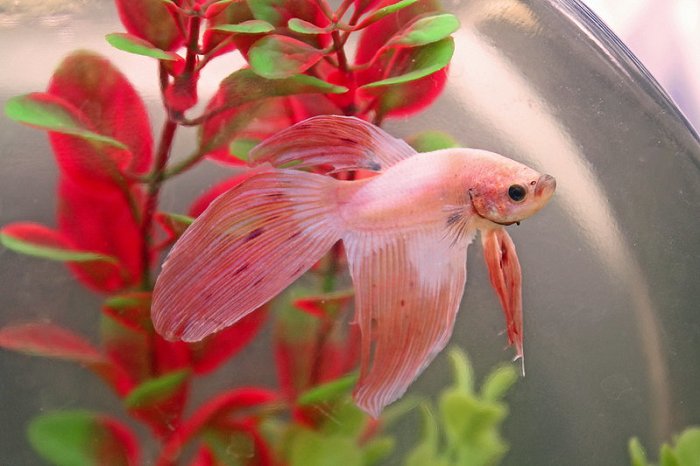
The pink Betta Fish is not one of the most common Betta varieties. Nevertheless, if you are lucky enough to track one down, you will find they make a great pet for both seasoned Betta Fish owners and newcomers to the species.
Not just limited to the delicate-looking pink orchid Betta, you will find this variety span tail shapes, different patterns, and fin length so that every pink Betta is a unique and stunning addition to your aquarium.


